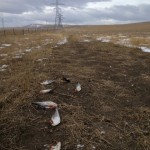Wednesday, January 8, 2014
 Photo: Looking west from Highway 785 at the point where the new transmission line crosses the highway, December 31, 2013
Photo: Looking west from Highway 785 at the point where the new transmission line crosses the highway, December 31, 2013Chris Davis, Pincher Creek Voice
A number of dead ducks were found underneath AltaLink electricity transmission lines adjacent to Highway 785 south of the Oldman River Dam. Area citizens first reported the deceased birds in early to mid December of 2013 after a cold snap.
I drove out to the site earlier today and discovered an AltaLink crew inspecting the area but my inquiries were directed to AltaLink spokesman Scott Schreiner.
According to Schreiner, “The first we heard of it was a phone call I received yesterday” (Wednesday, January 7). He said the incident was then reported by AltaLink to Alberta Sustainable Resource Development and to Fish and Wildlife, who are believed to have been on scene today December 8 as well.
According to David McIntyre, who took the photos included with this article, “The observed dead ducks appear to have been killed over a protracted period of time rather than, say, from one or two isolated incidents. I offer this due to seeing both freshly killed ducks and others that appeared to have been on the site for some time.”
McIntyre is a retired scientist, a noted area environmentalist, and among many other things is also a director of Canadian Parks and Wilderness Society (CPAWS).
 “The attached images show a currently-under-construction, 240kV AltaLink transmission line that’s located north of the town of Pincher Creek and Highway 3, south of the Oldman River valley and the Oldman Reservoir (created by water backed up from the Oldman Dam),” he explains in an email. “I took the pictures on Dec. 31, 2013.”
“The attached images show a currently-under-construction, 240kV AltaLink transmission line that’s located north of the town of Pincher Creek and Highway 3, south of the Oldman River valley and the Oldman Reservoir (created by water backed up from the Oldman Dam),” he explains in an email. “I took the pictures on Dec. 31, 2013.”
“If you look closely, you can see that transmission lines have been strung to the towers revealed in the first image, but have not yet been strung to the newly erected towers to the east.”
“Also visible in the first image are the remains of dead ducks that, from all appearances, have been killed as a result of collisions with the overhead lines. The pictured duck remains are the tip of a dead-duck iceberg that extends all along the newly erected transmission lines.”
McIntyre believes the new transmission lines have “within a very short period of time, killed hundreds of ducks due to high-speed—bone-breaking—collisions.”
He could not estimate the number of ducks he saw, but believed them all to be mallards, and he said he saw at “at least one Canada goose and one gray (Hungarian) partridge.”
“Seven eagles (a mix of golden and bald) were feeding on dead ducks during the brief time I stopped to examine the site, and one eagle was seen carrying off a dead duck. One rough-legged hawk and dozens of ravens were also at the site. This active feeding by avian scavengers suggests that many dozens of dead waterfowl may have already been removed from the area where they were killed. Regardless, the land beneath the pictured lines looks like an avian slaughterhouse. It’s littered with duck remains, and the ground, wherever there’s vegetation, has captured a carpet of windblown feather.”
McIntyre makes his opposition to the transmission lines very plain and offers his opinion of the situation quite candidly:
“It’s more than likely that ducks, flying in tight flocks, are particularly vulnerable—more than geese, or swans—to the new transmission lines, particularly in times of poor visibility. Regardless, it appears obvious that the line’s placement, directly between a key waterfowl staging area and adjacent grain fields—read “feeding areas”—couldn’t have been planned more effectively … if killing waterfowl had been its primary objective.”
“Almost overnight it’s become southern Alberta’s Dead Duck Cafe.”
Scott Schreiner said the causal factor(s) for the deaths was presently undetermined, but “When we heard about it we sent out a team to investigate. We’re taking this very seriously.”
“We’re the first company in Canada to put together an avian mitigation plan,” said Schreiner. “We want to find out exactly what happened so we can mitigate future events.” That may include installing devices on the line to make it more visible to birds.
We will follow up on this story as more information becomes available.
Correction “Area citizens first reported the deceased birds in early to mid December of 2013 after a cold snap.” edited from “Area citizens first reported the deceased birds in mid December of 2013 after a cold snap.”
![]()